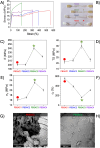Chemical-free Reactive Melt Processing of Biosourced Poly(butylene-succinate-adipate) for Improved Mechanical Properties and Recyclability
- PMID: 38807952
- PMCID: PMC11129176
- DOI: 10.1021/acsapm.4c00514
Chemical-free Reactive Melt Processing of Biosourced Poly(butylene-succinate-adipate) for Improved Mechanical Properties and Recyclability
Abstract
Biosourced and biodegradable polyesters like poly(butylene succinate-co-butylene adipate) (PBSA) are gaining traction as promising alternatives to oil-based thermoplastics for single-use applications. However, the mechanical and rheological properties of PBSA are affected by its thermomechanical sensitivity during its melt processing, also hindering PBSA mechanical recycling. Traditional reactive melt processing (RP) methods use chemical additives to counteract these drawbacks, compromising sustainability. This study proposes a green reactive method during melt compounding for PBSA based on a comprehensive understanding of its thermomechanical degradative behavior. Under the hypothesis that controlled degradative paths during melt processing can promote branching/recombination reactions without the addition of chemical additives, we aim to enhance PBSA rheological and mechanical performance. An in-depth investigation of the in-line rheological behavior of PBSA was conducted using an internal batch mixer, exploring parameters such as temperature, screw rotation speed, and residence time. Their influence on PBSA chain scissions, branching/recombination, and cross-linking reactions were evaluated to identify optimal conditions for effective RP. Results demonstrate that specific processing conditions, for example, twelve minutes processing time, 200 °C temperature, and 60 rpm screw rotation speed, promote the formation of the long chain branched structure in PBSA. These structural changes resulted in a notable enhancement of the reacted PBSA rheological and mechanical properties, exhibiting a 23% increase in elastic modulus, a 50% increase in yield strength, and an 80% increase in tensile strength. The RP strategy also improved PBSA mechanical recycling, thus making it a potential replacement for low-density polyethylene (LDPE). Ultimately, this study showcases how finely controlling the thermomechanical degradation during reactive melt processing can improve the material's properties, enabling reliable mechanical recycling, which can serve as a green approach for other biodegradable polymers.
© 2024 The Authors. Published by American Chemical Society.
Conflict of interest statement
The authors declare no competing financial interest.
Figures








References
-
- Ye H.; Jiang J.; Yang Y.; Shi J.; Sun H.; Zhang L.; Ge S.; Zhang Y.; Zhou Y.; Liew R. K.; Zhang Z. Ultra-Strong and Environmentally Friendly Waste Polyvinyl Chloride/Paper Biocomposites. Adv. Compos Hybrid Mater. 2023, 6 (2), 81.10.1007/s42114-023-00664-x. - DOI
-
- Ge S.; Shi Y.; Chen X.; Zhou Y.; Naushad Mu.; Verma M.; Lam S. S.; Ng H. S.; Chen W.-H.; Sonne C.; Peng W. Sustainable Upcycling of Plastic Waste and Wood Fibers into High-Performance Laminated Wood-Polymer Composite via One-Step Cell Collapse and Chemical Bonding Approach. Adv. Compos Hybrid Mater. 2023, 6 (4), 146.10.1007/s42114-023-00723-3. - DOI
-
- Khan W. U.; Bahar M. K.; Mazhar H.; Shehzad F.; Al-Harthi M. A. Recent Advances in Nitride-Filled Polyethylene Nanocomposites. Adv. Compos Hybrid Mater. 2023, 6 (6), 222.10.1007/s42114-023-00802-5. - DOI
-
- Meng X.; Yang H.; Lu Z.; Liu Y. Study on Catalytic Pyrolysis and Combustion Characteristics of Waste Cable Sheath with Crosslinked Polyethylene. Adv. Compos Hybrid Mater. 2022, 5 (4), 2948–2963. 10.1007/s42114-022-00516-0. - DOI
-
- Karimi-Maleh H.; Orooji Y.; Karimi F.; Karaman C.; Vasseghian Y.; Dragoi E. N.; Karaman O. Integrated Approaches for Waste to Biohydrogen Using Nanobiomediated towards Low Carbon Bioeconomy. Adv. Compos Hybrid Mater. 2023, 6 (1), 29.10.1007/s42114-022-00597-x. - DOI
LinkOut - more resources
Full Text Sources

